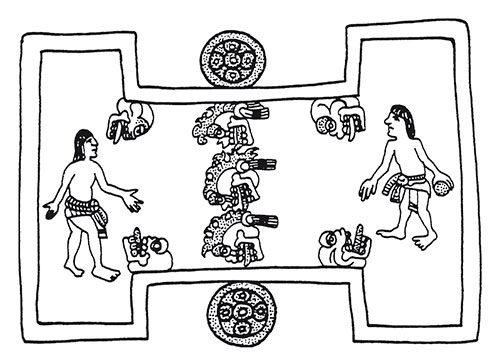3.3.1 What is an 'invention'?
The range of materials available is currently expanding at a high rate, giving designers a wide choice for a specific product. When a new material is introduced, inventive minds immediately examine the material for its new properties. This problem is not new, and can be illustrated by the introduction of rubber from the New World in the 18th century. It had been used by native Amerindians as a material for making pots and shoes, as well as for leisure activities such as ball games (see The discovery of rubber ).
It was formed by collecting liquid latex sap from one species of tree, boiling the water out of it, and then heating the semi-fluid resin product to harden over shaped formers. Rubber has substantial elasticity, and is capable of being extended to many times its original length (think of the extent to which you can stretch a rubber band). This elasticity also means that items made of rubber show tremendous bounce! No other materials behaved in this way so it naturally became the object of enquiry when it reached Britain in around 1750.
The discovery of rubber
Spain's desire to colonise South and Central America was driven by a greed for gold and silver. But of the many new discoveries made, one plant was destined to prove extremely valuable in the long term. It was Hevea brasiliensis , a large tree that exuded a latex sap when cut. When collected, the sap could be dried to a solid material and fabricated into many useful products. It was seen by Christopher Columbus during his second voyage between 1493 and 1496. He came across Amerindians playing a game with rubber balls. This game, known as the Sacred Ball Game, had been developed by Olmec Indians as early as 1000 BC. It was played only by the most important members of society in a rectangular court 283 feet long, 100 feet wide and 27 feet high (Figure 43).
After the solid ball was thrown into the court, the players had to pass it to team mates using hips, legs or elbows, and manoeuvre the ball into one of two rings in the centre of the court to score. Side bets were usual, and the winners had the right to strip spectators of clothing and jewellery. Omens were read from the way the game developed, as well as from the nature of the victory. Apparently the losing side could pay with their heads (as the drawing may suggest).
One of the first applications for rubber happened almost by chance. Rubbing small pieces of the material against pencil marks was found to remove them. Such a simple use would not be expected from a planned research effort! This is an example of invention by accident or happenstance, and in this case, the word 'rubber' became absorbed into the language as a term for an eraser.
What were the main features of this 'invention'? They were:
- The discovery was new (no one had done it before, apparently).
- The result was unexpected (not easily predicted from existing knowledge in that particular field) and not at all obvious to workers in the field (or art ).
- The effect could be applied to making a product for use by many people (it is capable of manufacture).
Moreover, once the discovery had been made, systematic research led to better erasers. It was found later that adding various fillers such as chalk would improve the effect. The filler actually weakens the rubber material, making it easier for pieces to be abraded away, and so taking the graphite smears of writing away more easily. So perhaps we ought to add another feature:
The basic invention was capable of improvement (better versions could be made).
The first three points are in fact incorporated into any legal framework for defining new inventions: they must be
- novel
- original (non-obvious)
- capable of manufacture (or otherwise realised in a functional way because not all patents cover mechanical devices).
Activity 19 (self-assessment)
Does the development of the safety lamp by Davy qualify as inventive according to the three main points given above? Justify your answer against each of the three points.
Answer
Davy's lamp design is inventive because:
- It was novel: no one had made such a design before.
- Presumably the use of the gauze was not obvious at the time, or it would have been used previously!
- The concept was applied successfully to making a product so it was clearly capable of manufacture.
Our definition of an invention : a novel idea that has been transformed into reality – given a physical form such as a description, sketch or model conveying the essential principles of a new product, process or system.
The three points are capable of application to any new product, whether inventive or not. Lawyers have codified them and developed specific legal tests to ensure that a new product can be evaluated for its originality. We have already come across the fourth criterion in the discussion of flame safety lamps. They show evolutionary development from the original Davy lamp, in addressing problems of integrity and longevity in the severe environment of the mine. Each individual improvement is patentable if it meets the three basic criteria of novelty, originality and manufacture. We have said already that there must be some context of need, and there must be some use for the invention.
The basic test used to evaluate any new material discovery is therefore to ask three specific questions:
- Is the application novel?
- Is the use original, or not obvious to a skilled practitioner?
- Can the material be manufactured for this specific application?
If it has not been used at all anywhere, then the application is novel, but if some record is found, or a witness comes forward who can attest the use of the same material in the same application, then it will not be novel, and the application cannot be inventive.
The second question is much more difficult to answer, and will depend on the skilled practitioner who responds. If a not dissimilar material had been used before in such an application, then it is conceivable that using the new material could well be obvious.
The final question is the most straightforward to answer. If the material is capable of manufacture, then it satisfies the third criterion.

